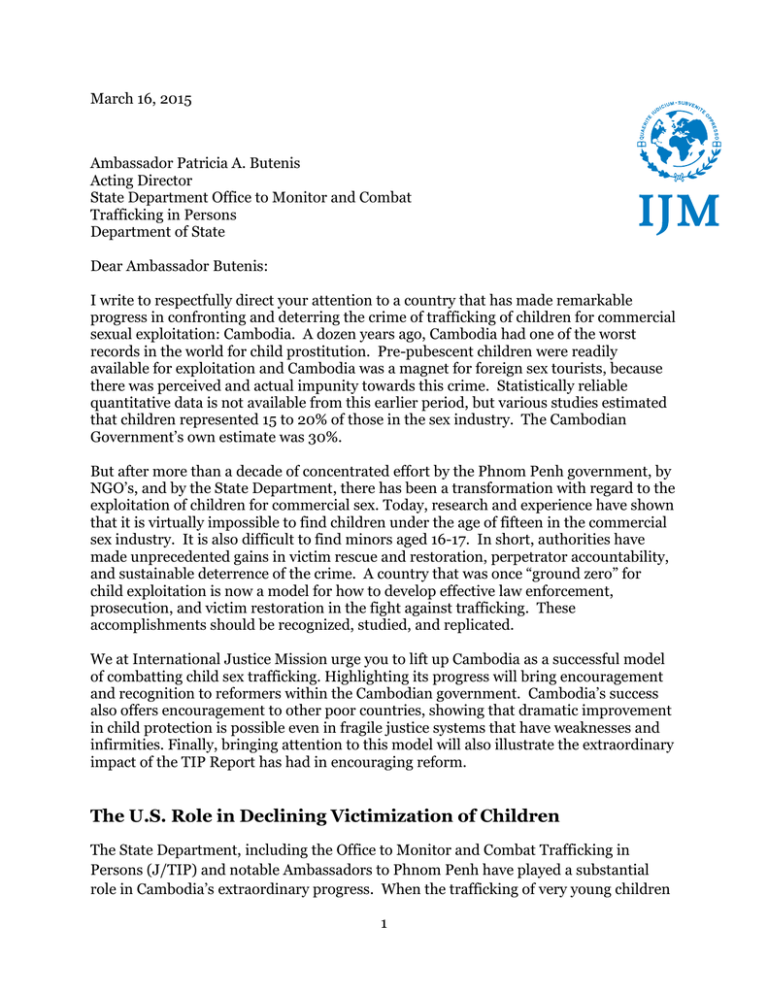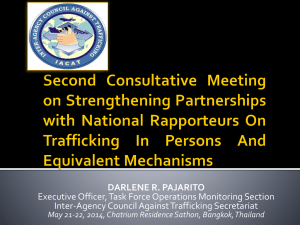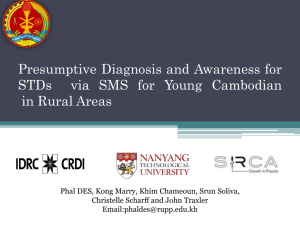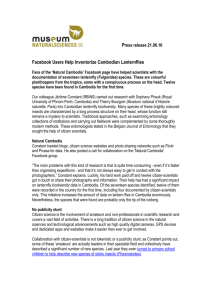cambodia-lettertotip-march2015-2
advertisement

March 16, 2015 Ambassador Patricia A. Butenis Acting Director State Department Office to Monitor and Combat Trafficking in Persons Department of State Dear Ambassador Butenis: I write to respectfully direct your attention to a country that has made remarkable progress in confronting and deterring the crime of trafficking of children for commercial sexual exploitation: Cambodia. A dozen years ago, Cambodia had one of the worst records in the world for child prostitution. Pre-pubescent children were readily available for exploitation and Cambodia was a magnet for foreign sex tourists, because there was perceived and actual impunity towards this crime. Statistically reliable quantitative data is not available from this earlier period, but various studies estimated that children represented 15 to 20% of those in the sex industry. The Cambodian Government’s own estimate was 30%. But after more than a decade of concentrated effort by the Phnom Penh government, by NGO’s, and by the State Department, there has been a transformation with regard to the exploitation of children for commercial sex. Today, research and experience have shown that it is virtually impossible to find children under the age of fifteen in the commercial sex industry. It is also difficult to find minors aged 16-17. In short, authorities have made unprecedented gains in victim rescue and restoration, perpetrator accountability, and sustainable deterrence of the crime. A country that was once “ground zero” for child exploitation is now a model for how to develop effective law enforcement, prosecution, and victim restoration in the fight against trafficking. These accomplishments should be recognized, studied, and replicated. We at International Justice Mission urge you to lift up Cambodia as a successful model of combatting child sex trafficking. Highlighting its progress will bring encouragement and recognition to reformers within the Cambodian government. Cambodia’s success also offers encouragement to other poor countries, showing that dramatic improvement in child protection is possible even in fragile justice systems that have weaknesses and infirmities. Finally, bringing attention to this model will also illustrate the extraordinary impact of the TIP Report has had in encouraging reform. The U.S. Role in Declining Victimization of Children The State Department, including the Office to Monitor and Combat Trafficking in Persons (J/TIP) and notable Ambassadors to Phnom Penh have played a substantial role in Cambodia’s extraordinary progress. When the trafficking of very young children 1 for commercial sexual exploitation came to the attention of the newly deployed American Ambassador to Cambodia, The Honorable Charles Ray, in January 2003, he raised the issue prominently with then-Interior Minister and Deputy Prime Minister Sar Kheng. Ambassador Ray’s recommendations carried particular weight in light of the fact that the 2002 State Department TIP Report had ranked Cambodia on Tier 3; a second year of Tier 3 ranking would incur sanctions and a reduction of U.S. assistance to Cambodia. The Interior Ministry directed its anti-trafficking police—which, under prior leadership, had been actively complicit in the commercial sexual exploitation of children—to collaborate with International Justice Mission (IJM) to rescue young children from brothels and apprehend perpetrators. Over the next several years, dozens of children were rescued and restored and many perpetrators were apprehended, prosecuted, and punished. The anti-trafficking police also requested and received training and mentorship from IJM in order to increase their capacity, ethics, and effectiveness at responding to TIP cases. The State Department’s J/TIP Office played a significant role throughout this period. The annual TIP Report reflected both Cambodia’s progress and setbacks. IJM can attest from our own experience that the Cambodian authorities at the highest levels took these reports seriously and on most occasions were extremely responsive to the criticisms offered. Cambodian police often requested feedback and assistance from IJM on how to improve their performance and meet JTIP’s expectations in order to raise Cambodia’s standing in the TIP Report. In 2008, Cambodia adopted the Law on the Suppression of Human Trafficking and Sexual Exploitation (the “TIPSE Law”). The new law brought Cambodia largely into alignment with international anti-trafficking standards but its implementation was flawed. Various police forces seized on its passage as an opportunity to execute sweeps and shakedowns throughout sex entertainment venues. The Cambodian military police, in particular, reportedly engaged in significant human rights abuses against women in the sex industry. The J/TIP Office raised concerns about this negative development in its 2008 TIP Report, downgrading Cambodia to Tier 3 status. The poor ranking bolstered reformers within the police and quickly helped to marginalize military police and others who had taken advantage of the 2008 act to prey on sex workers. The U.S. Government also played a significant part in Cambodia’s transformation by making grants to NGO’s in Cambodia for the rescue and restoration of trafficking victims and for the training and professionalization of the Cambodian police, courts, and social welfare office. As has been the case in many countries, the JTIP report’s 2 identification of weaknesses combined with targeted assistance to help governments address them has been a highly effective model. For example, in the early 2000’s, there were virtually no secure shelters offering trauma-focused, comprehensive care to young children who had been removed by police from sex venues. But thanks to grant-making from J/TIP, USAID and other donors to excellent NGO’s working in Cambodia over the course of the last decade, capacity grew to accommodate the particular needs of rescued children, and substantial expertise developed among providers. The best practice models in the world today for short and long-term care of child victims of commercial sexual exploitation were innovated and developed in Cambodia. The J/TIP-funded World Hope assessment center in Phnom Penh, for example, is a state-of-the-art model that we think should be replicated elsewhere to accommodate the unique needs of child victims of trafficking. Another example of the U.S. Government role in Cambodia’s transformation can be seen in the development of police professionalism. Cambodia’s Anti-Human Trafficking and Juvenile Protection Police (AHTJP) have now received over 10 years of professional training, mentorship and support. IJM has trained and mentored over 500 of those officers, and witnessed the clear progress seen in anti-trafficking police over the years: improved capacity, increased cases moving through the justice system, consistent numbers of victim rescues and criminal convictions, child friendly procedures consistently utilized, growing public trust in the anti-trafficking police, and strong government ownership over the fight against trafficking. Today, police are proactively, independently and successfully pursuing and responding to sex trafficking cases. Statistical Evidence of Transformation In 2012, IJM and several partners conducted an intensive prevalence study in Cambodia’s three largest cities – formerly the areas of highest availability of children for sexual exploitation. We found that young minors age 15 and younger represented less than 1% of those in prostitution. Older minors (ages 16-17) represented only 7.41% of the total. Since then, IJM’s experienced undercover operatives and police partners have investigated every single potential lead provided on child sexual exploitation throughout Cambodia. We’ve found almost no children under the age of fifteen and a substantial reduction in older minors (age 16-17) in entertainment venues. As expected, prosecution and conviction of child sex trafficking cases have been lower in recent years than they were earlier in the decade because there are actually fewer such crimes. We would, nonetheless, direct your attention to the fact that Cambodian courts invoke a number of penal code provisions for sexual and trafficking crimes. Thus, while the 2014 TIP Report mentioned 18 anti-trafficking cases prosecuted under TIPSE auspices (Cambodia’s anti-trafficking statute) it is our understanding that the Cambodian government reported 132 convictions for trafficking and sexual exploitation 3 (which includes foreign pedophile exploitation cases, rape cases with more than one victim, pornography abuse cases, etc.) under a variety of statutes. We encourage J/TIP experts to acknowledge all appropriate prosecutions and convictions for traffickingrelated crimes so as to appropriately convey the magnitude of the Cambodian Government’s response. Another measure of Cambodia’s progress can be seen in the authentically committed, experienced, knowledgeable leaders who are now moving into positions of higher leadership and authority within the Ministry of Interior, the Ministry of Justice, the Ministry of Women’s Affairs, the AHTJP police, and the Immigration Police. Similarly, the First Instance Court system has more first-time judges, prosecutors and clerks who are college educated, know the law, are employing child friendly practices, and want to do a good, ethical job. Our AHTJP police contacts state that they now have prosecutors in every province who proactively work with them and support their cases to move forward. This was not the case two or three years ago. An area of concern for Cambodian anti-trafficking stakeholders has been the absence of undercover investigative authority for the AHTJP. The TIP Report has highlighted this need in its recent reports, and the U.S. Embassy has raised it prominently with Cambodian Government interlocutors. IJM’s Cambodia team follows the issue very closely and provides technical expertise to the Cambodian government. We are encouraged by Minister of Interior Sar Kheng’s strong support of undercover authority for the AHTJP. This support was expressed in his directive to the Ministry of Justice to offer a legal amendment and approval of procedural guidance in the first half of 2015. The MOI knows that their police need this authority to process more covert trafficking cases. They have the full support from prosecutors across the nation. While this is a politically sensitive issue, the MOI and the MOJ have negotiated in good faith for considerable time on granting this authority, and we are confident that agreement is imminent. Perhaps the most important indicator of progress in Cambodia is the sustainability of anti-trafficking gains. After many years of collaboration with IJM on hundreds of individual cases, the AHTJP police are now proactively conducting investigations, rescues and apprehension of suspects entirely without IJM participation. Our AHTJP police partners are now regularly calling the Department of Social Welfare (DoSAVY) for social work assistance and ensuring that victims are referred to aftercare. This is the goal of sustainability that we have been working towards, and we believe that our police partners will work to achieve it. Labor Trafficking Of course, the TIP Report will also include information on Cambodia’s progress with regard to labor trafficking. While this has not been IJM’s casework type, we are 4 nonetheless aware of accelerated activity by our Cambodian Government partners in this area. Due to the prevalence decrease in sex trafficking, the vast majority of the conversation now (in civil society and government) is how to address labor migration and trafficking issues with the same success. As you are aware, the majority of labor trafficking issues in Cambodia are cross-border, with perpetrators of labor trafficking primarily in other ASEAN nations. As such, investigations and legal cases must be done collaboratively with foreign governments. Thus far, Thailand, Malaysia, Singapore, and Indonesia have been reluctant to respond and partner well with Cambodia on cross-border issues, though discussions are just beginning. In this regard, Cambodia’s MOU with Thailand last year to address crossborder labor trafficking issues is a big milestone. Another sign of progress on cross-border trafficking can be seen in the response by the Cambodian Government last year to the trafficking of Cambodian women to China for marriage. The Phnom Penh Government responded quickly, focused the immigration police on the issue, and has already had successful victim identification, rescue, arrests and convictions of the local traffickers/recruiters. The number of convictions will increase as more cases reach the courts. Authorities in Siem Reap are now also focusing on marriage trafficking cases going out of their airports. Political will to confront trafficking can also be seen in the government’s strengthening of the National Committee for Counter Trafficking (led by Chu bun Eng, Secretary of State for the Ministry of Interior) by giving it Royal Decree Power. (Royal Decree Power includes the ability to enforce directives to the various ministries and by increasing its staff and budget.) This will raise the profile of the government’s anti-trafficking measures, increase its enforcement abilities, and ensure participation of all ministries in the National Plan of Action for Counter Trafficking. The National Committee released its 2014-2018 National Plan of Action, which is much stronger than the preceding plan. The new plan was designed with full input from all ministries and key NGO’s. It focuses heavily on labor trafficking, and addresses a full spectrum of needs: cross-border cooperation on casework, regulatory development, technical guidance for ministries, victim identification and protection, expanded police and judicial official training at the sub-national level, and more. For its part, civil society has formed a Labor Forum to design a more comprehensive, strategic and complementary response to trafficking so as to support government initiatives. Among the Forum’s goals is the creation of more effective community-based victim identification, increased legal services in rural areas, vocational training and job creation programs, and trauma care programs. 5 The Ministry of Interior moved the Immigration Police into its own department and increased its budget and staff. The Immigration Police are focusing on key issues such as keeping transnational crime groups out of Cambodia, identifying marriage trafficking victims pre-departure, and promoting deportation of convicted foreign pedophiles. The police have already been a strong support to IJM, APLE, LSCW, IOM and other leading civil society agencies working on trafficking and exploitation issues, such as assisting with the deportation of several foreign pedophiles, training civil society groups on deportation policies at NGO-sponsored conferences, and following up on complaints of foreign organized crime groups. The Cambodian Government reported that in 2014 through government and civil society prevention and education initiatives, that over 1 million Cambodians received information about illegal, dangerous migration, trafficking and their rights. Celebrating Collaboration and Success In conclusion, IJM respectfully urges you to mark the transformation of Cambodia with respect to trafficking both in public ways (such as advancing Cambodia to Tier 2 in the 2015 TIP Report) and in U.S. diplomacy. While the victory belongs to government officials of good will in Cambodia, it is a success that the U.S. Government – and especially the TIP Office – can take great pride in as well. Tough U.S. diplomacy and hard-hitting TIP Reports helped make trafficking in Cambodia a priority for the Cambodian Government and anti-trafficking assistance helped them develop best practices in Southeast Asia. We urge you to highlight the power of U.S. diplomacy, resources and engagement to help a fragile nation confront and overcome the worst experience of young child commercial sexual exploitation we have seen anywhere in the world. Sincerely, Sharon Cohn Wu Senior Vice President for Justice System Transformation 6






![Cambodian New Year - Rotha Chao [[.efolio.]]](http://s2.studylib.net/store/data/005298862_1-07ad9f61287c09b0b20401422ff2087a-300x300.png)